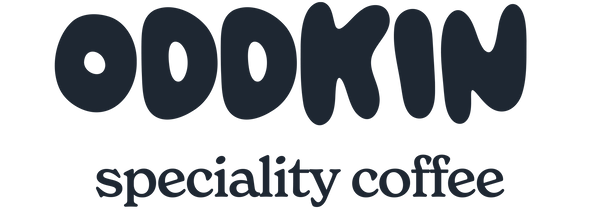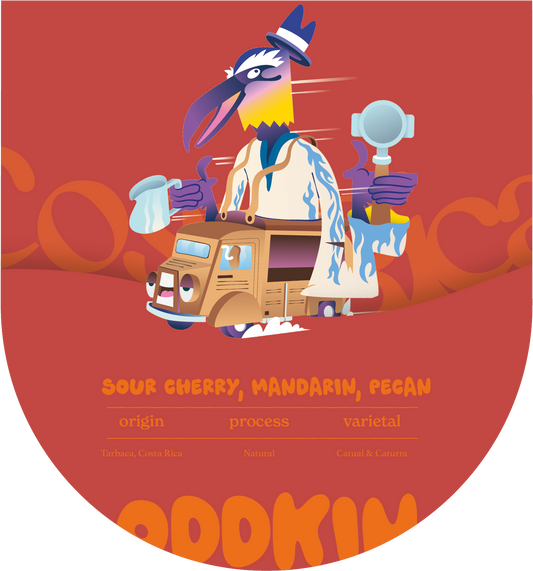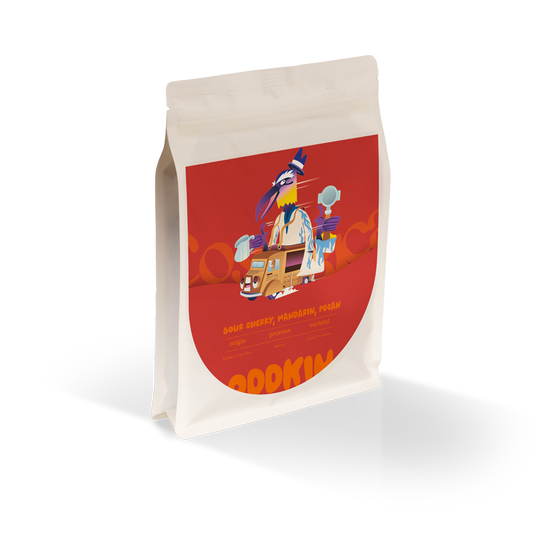How to use a Cafetiere with OddKin
The OG of all immersion brewing- the Cafetiere!
This simple brew style boasts bold, rich results in every cup and retains more of the coffee grounds natural oils within your brew.
- What is cafetiere coffee?
- Is cafetiere the same as French press?
- What you’ll need to get brewing
- How to make cafetiere coffee
- Cafetiere coffee FAQs
What is cafetiere coffee?
A Cafetiere is shaped like a narrow beaker, which has a strainer attached to the lid.
Also fitted with a plunger that traditionally you’d push down at the end of the brewing process to keep the grinds at the base.
Is a Cafetiere and a French press the same thing?
‘Cafetiere’ is the French word for coffee pot, and this method of brewing is also referred to as French press.
The idea behind this brewing style is thought to date all the way back to the 1920s when people in France used steel rods and cheesecloth screens to press coffee into cups and pots.
However, despite having origins in France, the first French Press design similar to the one we know today was invented in Italy by Ugo Paolini.
He licensed his designs to Attilo Calimani and Giulio Moneta, who then patented the press in 1929.
How to use a Cafetiere
- Kettle
- Timer
- Odd Kin’s speciality coffee (grind type: whole bean or French press)
- Cafetière
- Spoon
- Coffee scales / measuring scoop
How to make cafetiere coffee:
(Makes 1 cup- scale up as needed)
You’ll need:
-
15-18g coffee (grind size: coarse)
-
250ml filtered water
-
Cafetiere
-
Kettle
-
Timer
-
Spoon
Step 1: Boil your kettle and leave the water to rest for 30 seconds to 1 minute. Preheat your Cafetiere with hot water and discard.
Step 2: Grind your coffee and add to the Cafetiere, followed by 250ml hot water.
Step 3: Gently stir the coffee 3 times with a spoon to ensure all grounds are wet.
Step 4: Allow to brew for 3 - 4 mins
Step 5: Use a spoon to gently scoop out any sediment that floats to the top of the coffee.
Step 6: Allow to rest for a further 4 - 5 minutes. Then, push the plunger down to precisely the level of the liquid and no further. Now, all that’s left to do is decant your coffee into cups. Et voila! Your coffee is served.
Top Tip: We recommend using fresh, filtered water to allow for a fuller flavoured brew.
Cafetiere Coffee FAQs
What is the best Cafetiere grind size?
We recommend a medium-coarse to coarse grind size.
Each coffee particle will be between 0.75 - 1 mm in size, with the same texture of rough sand.
For tastiest results, grind your coffee just before you brew. This ensures you keep all the freshness and aromatics in your coffee that you’d typically lose when pre-ground.
However, if you don’t have access to a grinder we offer pre-ground options too.
What coffee to water ratio is best for a Cafetiere?
We recommend a ratio of 1:15.
This means that for every 15-18g of coffee you use you’ll need 250ml of boiling water.
What are the benefits of Cafetiere coffee?
-
No paper filters are used: this means that more of the oils inside the coffee beans are able to get into the brew resulting in a richer flavour and a heavier mouthfeel.
-
An affordable option.
-
Make multiple cups of coffee: depending on the size of your Cafetiere, you can brew up to 6 - 8 cups at once - great when you have company.
-
Reusable way to brew: No single use parts.
How can I reduce sediment in French press coffee?
This sediment that is classic when brewing a Cafetiere comes from extra fine coffee particles which don’t dissolve - and as a result, taste gritty or thicker.
To avoid this problem, we recommend:
-
Using a medium to medium-coarse coffee grind (which will make it more difficult for the grounds to be separated).
-
Stir your coffee gently and move any sediment that floats to the stop (see step 5).
-
Don’t rush the process, allowing your coffee to rest will give the grounds time to sink to the bottom of the press.
-
Plunge slowly and avoid plunging below the level of the liquid.
How do you clean a Cafetiere?
For best results, clean your Cafetiere after each use to avoid the build up of coffee oils that can go rancid over time.
To clean a French press, fill it roughly halfway with water and stir with the used grinds before pouring into a strainer. Discard the grinds and refill the press with lukewarm water and soap, use the plunger to pump the water up and down, deeply cleaning the sides.
Want to know more about different ways to brew your beans?
Join one of our fun weekend classes at the OddKin roastery! Suitable for all levels of experience. Bring a pal and mess around with some fab coffee for a morning or afternoon.
Click below to read more and see our available classes:
https://www.oddkincoffee.com/pages/coffee-classes
















